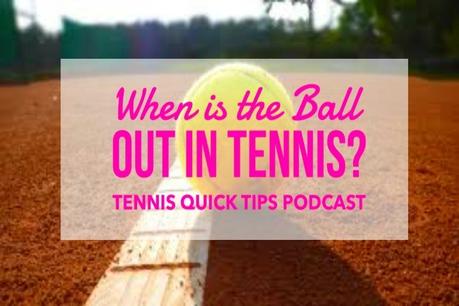So, when is the ball out? Is it out when I call it out? Is it out when my partner calls it out? Is it out if my opponent sees it out? Or is it only out when it is actually out? Hmmmm . . . In this episode, I'll let you know exactly when the ball is out in tennis! You can listen to this episode by clicking on the media player in this post or by listening in with your favorite podcast app. You can also subscribe in iTunes by clicking on this link: tennisfixation.com/itunes.

SHOW NOTES
You guys have been fantastic at continuing to send me your questions over the past two years. I really appreciate it! So let's get to a tennis quick tip!
Many, many of your questions are rules questions and, if you've listened to this podcast for a while now, you know - I love to talk about the rules!
So here's a questions I received very recently from Tennis Quick Tips listener Phyllis. Phyllis says:
When you are playing doubles and your partner calls the ball out, I feel this should be the end of the point. My friend thinks he can hit the ball back and try to win the point if the ball didn't go out. By calling the ball out I think that stops play for all. What should happen?
So when I look at Phyllis's question, I think what she is asking is first of all, who makes the call as to whether the ball is in or out? It sounds like in her match, her partner called a ball out but her opponent continued to play the ball because the opponent thought the ball was in. So what should happen? Is the ball out because her partner called it out? Or is it in if the opponent thinks it's in and continues to play?
What we need to do here is look to the rules, of course. I'm here in the United States where the USTA had adopted the ITF Rules of Tennis and the Code and these almost always apply to any tennis match you play. Even if you're in another country, not the United States, I promise you - the ITF Rules of Tennis most likely apply to you and it is very likely that the Code also applies. You should definitely be carrying a copy of the Rules and the Code in your tennis bag for these on-court situations where either a rules dispute arises or you're just not sure what the rule is.
So let's look at the Rules and the Code to figure out Phyllis's question. First, I can tell you, the Rules do not tell us who gets to make the call of whether a ball is in or out. Rule 12 tells us that "If a ball touches a line, it is regarded as touching the court bounded by that line." In other words, a ball is in if it lands inside the court or lands on the line. And that also means, if any part of the ball at all touches the line, the ball is in. Even if one of the fuzzy little hairs on the ball touches the line and the rest of the ball does not, the ball is still in.
And the Code confirms this in Paragraph 7, which states "If any part of a ball touches a line, the ball is good. A ball 99% out is still 100% good. A player shall not call a ball out unless the player clearly sees the space between where the ball hits and a line."
But the Rules do not tell us who makes that call. We have to look at the Code to get that answer. So here's what the Code says. First, in Paragraph 5, the Code tells us " Player makes call on own side of net. A player calls all shots landing on, or aimed at, the player's side of the net." So, in Phyllis's scenario, when the ball was on Phyllis's side of the court, either her or her partner can call the ball in or out. Not the opponents. And whatever call one partner makes, stands for both. We know this because Paragraph 9 or the Code says " Either partner may make calls in doubles. Although either doubles partner may make a call, the call of a player looking down a line is more likely to be accurate than that of a player looking across a line."
So once Phylllis's partner called the ball out, she's right, the ball was out. The opponent does not make that call since the ball was not on his or her side of the net. At least, that's what I'm picturing from Phyllis's question. The point was over. There was no reason for the opponent to keep playing the ball.
But was it wrong for the opponent to hit the ball after the call was made? Well, maybe or maybe not. I can imagine myself hitting a ball after it is called out just because I was already in motion. In other words, sometimes the out call comes and you are already anticipating what shot you will be hitting. You're already setting up for it and you just can't stop yourself from hitting the ball.
But that doesn't really sound like what Phyllis is asking about. She says that her opponent not only hit the ball after it was called out, but was trying to win the point as if the ball didn't go out. How would that be appropriate or even possible? Maybe the opponent thought the call was not just wrong, but might be reversed. I guess that is possible. The Code does say, in Paragraph 12, "A player who calls a ball out shall reverse the call if the player becomes uncertain or realizes that the ball is good. The point goes to the opponent and is not replayed." So maybe that's what happened. But obviously, if that is what happened, it wouldn't be necessary for the opponent to hit the ball back because the Code says the opponent gets the point when the call is reversed or if the caller is uncertain. The opponent doesn't have to keep playing.
I'm just throwing that one out there so that you know - if you reverse your call, your opponent gets the point. It's not a let. And if you and your partner disagree on a call, one of you says it's in while the other says it's out, again, your opponent will get the point. Check out the Code, Paragraph 14, for what happens when partners disagree.
All of this is a round-about way of saying, yes, Phyllis, when your partner called that ball out on your side of the net, play should have ended and your opponent should have not have continued to try and win the point. Maybe his return of the ball was just a reflex and possibly, maybe, it was a little rude to continue depending on the timing. But once your partner made the out call, the ball was out and the point was over.
The big lesson here is one I'm always touting - know the rules. Carry the rules with you. Don't lose out on points because someone else claims they know the rules and you find out later that they were wrong.
SHARE, SUBSCRIBE AND REVIEW
I would love it if you would take a minute to leave your review on iTunes. Just click here: Tennis Quick Tips on iTunes. It will help the show become more easily discovered by like-minded, awesome people just like you. And if you want to make sure you never miss an episode, be sure and subscribe on your smart device. You can click here to find the show in iTunes: Tennis Quick Tips on iTunes. Or you can click here to find the show in Stitcher: Tennis Quick Tips on Stitcher.

© Kim Selzman 2019 All Rights Reserved

Podcast: Play in new window | Download

